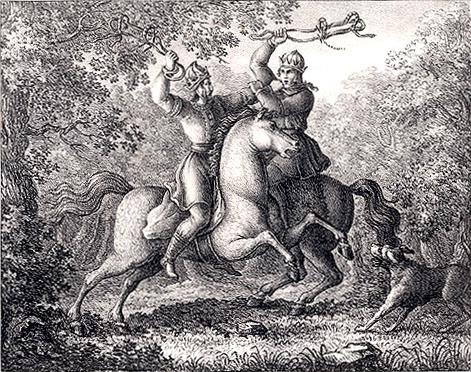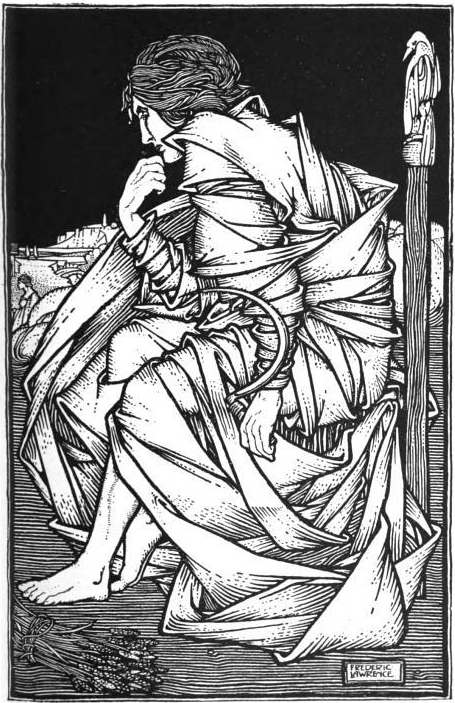|
Yngling
The Ynglings were a dynasty of kings, first in Sweden and later in Norway, primarily attested through the poem ''Ynglingatal''. The dynasty also appears as Scylfings (Old Norse ''Skilfingar'') in ''Beowulf''. When ''Beowulf'' and ''Ynglingatal'' were composed sometime in the eighth to tenth centuries, the respective scop and skald (poet) expected his audience to have a great deal of background information about these kings, which is shown in the allusiveness of the references. According to sources such as ''Ynglingatal'' and ''Íslendingabók'', the Fairhair dynasty in Oppland, Norway was in fact a branch of the Ynglings. Saxo Grammaticus held that Eric the Victorious, whom modern regnal lists usually begin with, and his descendents were also Ynglings, but this does not tally with Icelandic sources. The dynasty claimed descent from the gods Freyr and Njörðr, and other kings were likely mythical as well, whereas others may have been real: especially Egil, Ottar, Ale and Adils ... [...More Info...] [...Related Items...] OR: [Wikipedia] [Google] [Baidu] |
Ynglingatal
''Ynglingatal'' or ''Ynglinga tal'' (Old Norse: 'Enumeration of the Ynglingar') is a Skaldic poem cited by Snorri Sturluson in the ''Ynglinga saga'', the first saga of Snorri's ''Heimskringla''. Þjóðólfr of Hvinir (Thjodolf), who was a poet for Harald Fairhair (r. 872–930), is traditionally credited with its authorship. Snorri quotes frequently from this poem and cites it as one of the sources of the saga. The composition of the poem is dated to the 9th century. The poem lists the partly mythical and partly historical ancient Swedish kings; twenty-seven of whom are mentioned in the poem, along with details about their deaths and burial places. The title ''Ynglingatal'' alludes to Yngling, who had the name Yngve-Frey—another name for Frey, the god who was worshipped in Sweden. Yngling allegedly descended from Frey's son Fjölnir. Snorri portrayed Harald Fairhair as a descendant of the Ynglings. The poem was written on behalf of Ragnvald the Mountain-High, a cousin of K ... [...More Info...] [...Related Items...] OR: [Wikipedia] [Google] [Baidu] |
Ynglinga Saga
''Ynglinga saga'' ( ) is a Kings' saga, originally written in Old Norse by the Icelandic poet and historian Snorri Sturluson about 1225. It is the first section of his ''Heimskringla''. It was first translated into English and published in 1844 by Samuel Laing. Snorri Sturluson based his work on an earlier '' Ynglingatal'' which is attributed to the Norwegian 9th-century skald Þjóðólfr of Hvinir, and which also appears in '' Historia Norwegiae''. It tells the most ancient part of the story of the House of Ynglings (''Scylfings'' in ''Beowulf''). Snorri described the descent of the kings of Norway from this royal house of Sweden. ''Ynglinga saga'' is the first part of Snorri's history of the ancient Norse kings, the ''Heimskringla.'' Snorri's work covers the history of the Norwegian kings from the mythical prehistoric age until 1177, with the death of the pretender Eystein Meyla. Interwoven in this narrative are references to important historical events. The saga dea ... [...More Info...] [...Related Items...] OR: [Wikipedia] [Google] [Baidu] |
Eadgils
Eadgils, ''Adils'', ''Aðils'', ''Adillus'', ''Aðísl at Uppsölum'', ''Athisl'', ''Athislus'' or ''Adhel'' was a semi-legendary king of Sweden, who is estimated to have lived during the 6th century. ''Beowulf'' and Old Norse sources present him as the son of Ohthere and as belonging to the ruling Yngling (Scylfing) dynasty. These sources also deal with his war against Onela, which he won with foreign assistance: in ''Beowulf'' he gained the throne of Sweden by defeating his uncle Onela with Geatish help, and in two Scandinavian sources ('' Skáldskaparmál'' and '' Skjöldunga saga''), he is also helped to defeat Onela in the Battle on the Ice of Lake Vänern, but with Danish help. However, Scandinavian sources mostly deal with his interaction with the legendary Danish king Hrólfr Kraki (Hroðulf), and Eadgils is mostly presented in a negative light as a rich and greedy king. Snorri Sturluson, who documented many of the Scandinavian traditions, reported that the Swede ... [...More Info...] [...Related Items...] OR: [Wikipedia] [Google] [Baidu] |
Ongenþeow
Ongentheow (Old English: ''Ongenþeow'', ''Ongenþio'', ''Ongendþeow''; Old Norse: ''Angantýr'') (died ca. 515) was the name of a semi-legendary Swedish king of the house of Scylfings, who appears in Old English sources. He is generally identified with the Swedish king Egil Vendelcrow mentioned in '' Ynglingatal'', '' Historia Norwegiae'' and in ''Ynglinga saga''. The reason why they are thought to have been the same is that each has the same position in the line of Swedish kings and is described as the father of Ohthere and grandfather of Eadgils. The name Ongentheow contains as its second element '' þeōw'' "servant, slave". The first appears to be ''ongēan'' "against, opposite". Old English sources ''Beowulf'' In the Old English epic poem ''Beowulf'', Ongentheow is described as a fearsome warrior, and it took two Geatish warriors Eofor and Wulf Wonreding to take him down. The epic tells that the Geats under their new king Hæþcyn captured the Swedish quee ... [...More Info...] [...Related Items...] OR: [Wikipedia] [Google] [Baidu] |
Alrik Och Erik Döda Hvarandra Med Sina Hästbetsel By Hugo Hamilton
Alaric and Eric (Old Norse: ''Alrekr'' and ''Eiríkr''), according to legend, were two kings of Sweden. In the ''Ynglinga saga'' According to the ''Ynglinga saga'', Alaric and Eric were sons and heirs of the previous king Agni. They shared the kingship. They were mighty both in war and sport, but were especially skillful horsemen and vied with one another about their horsemanship and their horses. One day they rode off from their retinue and did not return. They were found dead with their heads battered but no weapons with them save the bridle bits of their horses. Accordingly it was believed that they had quarreled and come to blows and had slain each other with their bridle bits. They were succeeded by Alaric's sons Yngvi and Alf. However, in other sources, only Alaric died, and in the piece of Ynglingatal quoted by Snorri Sturluson it is only Alaric who dies explicitly. Eric's death seems to be a misunderstanding on Snorri's part due to an influence from the succeeding king ... [...More Info...] [...Related Items...] OR: [Wikipedia] [Google] [Baidu] |
Freyr
Freyr (Old Norse: 'Lord'), sometimes anglicized as Frey, is a widely attested god in Norse mythology, associated with kingship, fertility, peace, and weather. Freyr, sometimes referred to as Yngvi-Freyr, was especially associated with Sweden and seen as an ancestor of the Swedish royal house. According to Adam of Bremen, Freyr was associated with peace and pleasure, and was represented with a phallic statue in the Temple at Uppsala. According to Snorri Sturluson, Freyr was "the most renowned of the æsir", and was venerated for good harvest and peace. In the mythological stories in the Icelandic books the ''Poetic Edda'' and the '' Prose Edda'', Freyr is presented as one of the Vanir, the son of the god Njörðr and his sister-wife, as well as the twin brother of the goddess Freyja. The gods gave him Álfheimr, the realm of the Elves, as a teething present. He rides the shining dwarf-made boar Gullinbursti and possesses the ship Skíðblaðnir which always has a favorab ... [...More Info...] [...Related Items...] OR: [Wikipedia] [Google] [Baidu] |
Yngvi
Old Norse Yngvi , Old High German Ing/Ingwi and Old English Ingƿine are names that relate to a theonym which appears to have been the older name for the god Freyr. Proto-Germanic *Ingwaz was the legendary ancestor of the Ingaevones, or more accurately ''Ingvaeones'', and is also the reconstructed name of the Elder Futhark rune ᛜ and Anglo-Saxon rune ᛝ, representing '' ŋ''. A torc, the so-called " Ring of Pietroassa", part of a late third to fourth century Gothic hoard discovered in Romania, is inscribed in much-damaged runes, one reading of which is ''gutanī (ng)i hailag'' "to Ingwi of the Goths holy". Etymology Old Norse ''Yngvi'' as well as Old High German ''Inguin'' and Old English ''Ingƿine'' are all derived from the Proto-Germanic *Ingwaz. Sound changes in late-Proto-Germanic transformed *Ingwaz into *Ingwi(z) in the nominative case and *''Ingwin'' in the accusative case. His epithet * Fraujaz appears in Old Norse compounds ''Ingvifreyr'' and ''Ingunarfr ... [...More Info...] [...Related Items...] OR: [Wikipedia] [Google] [Baidu] |
Fairhair Dynasty
The Fairhair dynasty ( no, Hårfagreætta) was a family of kings founded by Harald I of Norway (commonly known as "Harald Fairhair", ''Haraldr inn hárfagri'') which united and ruled Norway with few interruptions from the latter half of the 9th century. In the traditional view, this lasted until 1387, however, many modern scholars view this rule as lasting only three generations, ending with Harald Greycloak in the late 10th century. The moniker "''Fairhair dynasty''" is a retrospective construction: in their lifetime what little traces there are refer to them consistently as " Ynglings". Dynasty itself: traditional view vs artificial construct The Fairhair Dynasty is traditionally regarded as the first royal dynasty of the united kingdom of Norway. It was founded by Harald I of Norway, known as ''Haraldr hinn hárfagri'' (Harald Fairhair or Finehair), the first King of Norway (as opposed to "in Norway"), who defeated the last resisting petty kings at the Battle of Hafrsfj ... [...More Info...] [...Related Items...] OR: [Wikipedia] [Google] [Baidu] |
House Of Munsö
The House of Munsö (), also called the House of Björn Ironside (Swedish: ), the House of Uppsala (Swedish: ) or simply the Old dynasty (Swedish: ), is the earliest reliably attested royal dynasty of Sweden, ruling during the Viking Age. None of the names suggested for the dynasty are universally accepted and most are problematic; the name "House of Munsö" derives from a questionable and speculative theory that they would have ruled from the island of Munsö and the name "House of Björn Ironside" derives from the supposed founder of the dynasty, Björn Ironside, who is often seen as a legendary, rather than historical, figure. A long and elaborate sequence of kings of the Munsö dynasty can be found in 12th and 13th century Icelandic sagas, but the sagas are overwhelmingly considered unreliable, with the kings that appear in them seen as legendary figures. The sequence of kings in the sagas is contradicted by more contemporary German sources such as the 9th century writings ... [...More Info...] [...Related Items...] OR: [Wikipedia] [Google] [Baidu] |
Ohthere
Ohthere (also ''Ohtere''), Old Norse ''Óttarr vendilkráka'' (''Vendelcrow''; in Modern Swedish ''Ottar Vendelkråka'') was a semi-legendary king of Sweden of the house of Scylfings, who is said to have lived during the Germanic Heroic Age, possibly during the early 6th century (fl. c. 515 – c. 530"Ottar" Encyclopedia Nordisk familjebok). His name can be reconstructed as *''Ōhta-harjaz'' or *''Ōhtu-harjaz''. The '' harjaz'' element is common in Germanic names and has a meaning of "warrior, army" (whence English '' [...More Info...] [...Related Items...] OR: [Wikipedia] [Google] [Baidu] |
Halfdan The Old
Halfdan the Old (Old Norse: ''Hálfdanr gamli'' and ''Hálfdanr inn gamli'') was an ancient, legendary king from whom descended many of the most notable lineages of legend. A second Halfdan the Old is the purported great-grandfather of Ragnvald Eysteinsson. Halfdan the Old, ancestor of many lineages ''Hyndluljód'' The eddic poem ''Hyndluljód'' states in verses 14–16: "Of old the noblest of all was Áli, Before him Halfdan, foremost of Skjöldungs 'Skjǫldungar'' Famed were the battles the hero fought, To the corners of heaven his deeds were carried. "Strengthened by Eymund 'Eymundr'' the strongest of men, Sigtrygg 'Sigtryggr''he slew with the ice-cold sword; His bride was Álmveig 'Álmveigr'' the best of women, And eighteen boys did Álmveig bear him. "Hence come the Skjöldungs, hence the Skilfings, Hence the Ödlings 'Ǫðlingar'' & ... [...More Info...] [...Related Items...] OR: [Wikipedia] [Google] [Baidu] |







